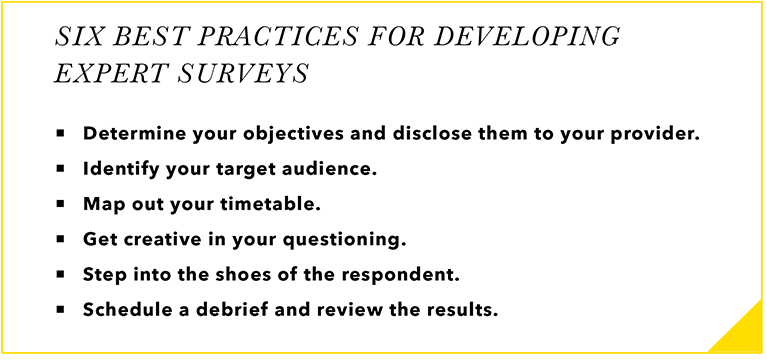Six Best Practices for Developing Expert Surveys

When you need quantitative insights fast, many firms turn to expert surveys conducted by research services providers. Surveys enable users to reach a large number of experts in a short amount of time. And with multiple data points revealed at once, analysts can obtain statistically significant understandings, pinpointing where experts are in agreement and where there is dissent.
Scale, speed, validation: all good reasons to turn to expert surveys. But to obtain the insights you and your organization need, analysts must optimize the development and deployment of questionnaires to the right pool of respondents. Do you apply these six best practices to your expert surveys?
1. Determine your main objectives and disclose them to your provider
Even well-written and -developed surveys can flop fast if they fail to match your business objectives. “Beginning with the end” will keep the survey focused and help to create a product blueprint.
What are the goals of the survey? What knowledge are you seeking? Are you looking for raw numbers or anecdotes? Are you aiming to round out your research and support a hypothesis or is this a starting point?
These answers will prove to be essential. By identifying and disclosing your survey objectives, your research provider will be able to determine the best types of questions for your survey, optimize word choice, and recruit the right respondents, maximizing the ability to find you the data you seek.
2. Identify your ideal target audience
After you defined your goals, it’s time to determine the respondents. This process goes beyond target industry and job titles. Consider the following questions:
How many total respondents do you seek? If you are launching with a sample group first, how many initial respondents?
Are there geographic restrictions? (For example, is the survey U.S.-based? State-based? Across various continents?)
What job functions are you looking for? (Are you looking for C-level executives or physicians?)
If you are segmenting your survey, what is the quota for each demographic?
Who would be ineligible? What types of respondents should not participate?
Do you need to tailor the experts you seek to categories of experts that adhere to your organization’s and provider’s compliance policies?
Once you’ve determined these attributes (known as screening criteria), your provider will be able to recruit the most appropriate professionals more efficiently. Communicating this criteria will also give you and your provider a realistic expectation for the survey project’s overall timeline, including custom recruiting time.
3. Map out your timetable
Analysts work in a fast-paced environment, but how fast? Is the project time-sensitive and you need immediate insights? Or do you have a longer timeline to gather even deeper insights?
Your provider should be able to commit to delivering results from most surveys within a week or two, but sometimes a more rapid turnaround is needed. Be sure to communicate your requirements. And when outlining your timeline — from identifying targets to formulating questions to deployment and delivering results — be prepared for your provider to ask you about your preferred schedule for deadlines and check-ins.
At Guidepoint, we like to keep our clients in the loop and updated on projects. We will communicate the status of recruiting and may be able to put preliminary data in your hands within hours. But, we also recognize that check-ins are always helpful to keep projects on track. If you’ve had a change in strategy, or you’ve switched up the screening criteria, check-ins are great times to inform your provider.
4. Get creative in your questioning
When formulating questions, brainstorm the best possible ways of presenting questions to get you closer to the type of data you’re looking for. Perhaps a visual or chart will get a complicated message across more clearly. Or if you’re looking to measure preferences, a rating scale is often best. The optimum mix of open- and closed-ended questions can solicit meaningful insights.
If you’ve disclosed your project’s overall objective, your provider can work with you to develop questions that will add value. At Guidepoint, we recommend clients draft an initial set of questions or bullet points and will work with you to evaluate the pros and cons of each question to elicit your ideal results. Once the survey is final, we ask clients to sign off on the questionnaire.
5. Step into the shoes of the respondent
By stepping into the shoes of the expert, you might find ways to better optimize your questionnaire.
For instance, taking a survey online can prove to be a different user experience than reading it on paper. There are reader pauses, moments to digest and answer questions, and the occasional interruption. These events can easily add five to 10 minutes to a completion time.
To avoid this, physically take the survey and ask yourself the following:
Does the survey take longer than expected?
In the mind of an expert, are the questions easy to understand?
Does the question flow make sense?
Is the survey efficient for the respondent?
Review these answers and edit your questionnaire as necessary. Your provider’s survey analysts will also be able to evaluate questions and analyze data from two perspectives, the client and the expert, avoiding situations like survey fatigue and ambiguous data at survey completion.
6. Schedule a debrief and review the results
After you’ve received your final results, request a review of the results. Communicate if you’re satisfied with the data or if you’d like to recruit more respondents. If data points are unclear, have your provider explain the report. Want the data in another format? Let your provider know.
Before the project officially wraps, make sure that all of your needs have been met and you’ve provided enough feedback to ensure the next project is even more seamless.


